Usuario "raulito"
Se han encontrado 162 Coincidencias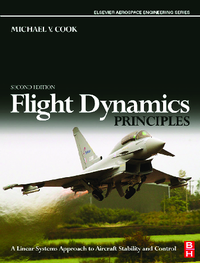
Flight Dynamics Principles
85 Visitas | 106 Descargas | 2014-05-08 16:27:01 | raulito
It is ten years since this book was first published and during that time there has been a modest but steady demand for the book. It is apparent that during this period there has been a growing recognition in academic circles that it is more appropriate to teach “Aircraft stability and control’’ in a systems context, rather than the traditional aerodynamic context and this is a view endorsed by industry. This is no doubt due to the considerable increase in application of automatic flight control to all types of aircraft and to the ready availability of excellent computer tools for handling the otherwise complex calculations. Thus the relevance of the book is justified and this has been endorsed by positive feedback from readers all over the world. The publisherwas clearly of the same opinion, and a second editionwas proposed. It is evident that the book has become required reading for many undergraduate taught courses, but that its original emphasis is not ideal for undergraduate teaching. In particular, the lack of examples for students to work was regarded as an omission too far. Consequently, the primary aim of the second edition is to support more generally the requirement of the average undergraduate taught course. Thus it is hoped that the new edition will appeal more widely to students undertaking courses in aeronautical and aeronautical systems engineering at all levels.

Hidráulica de ríos y procesos morfológicos
65 Visitas | 77 Descargas | 2014-05-08 16:47:10 | raulito
El objetivo original de este trabajo fue la recopilación y traducción coherente de un material escrito originalmente en ruso y en inglés, y algunos textos en espanol, suficiente como para aplicar a un doctorado en estos aspectos, complementado con con algunos resultados de la experiencia de 30 años del autor en la consultoría de tópicos relacionados. Sin embargo, terminando el ejercicio de investigación se consideró pertinente efectuar su publicación con el propósito de compartir este proceso de aprendizaje.

Chemical Engineering Design and Analysis. An introduction.
57 Visitas | 76 Descargas | 2014-05-08 17:29:56 | raulito
Students taking their first chemical engineering course plunge into the "nuts and bolts" of mass and energy balances, often missing the broad view of what chemical engineers do. This innovative text offers a well-paced introduction to chemical engineering. The text helps students practice engineering. They are introduced to the fundamental steps in design and three methods of analysis: mathematical modeling, graphical methods, and dimensional analysis. In addition, students apply engineering skills, such as how to simplify calculations through assumptions and approximations; how to verify calculations, significant figures, spreadsheets, graphing (standard, semi-log and log-log); and how to use data maps. It also describes the chemical engineering profession. Students learn engineering skills by designing and analyzing chemical processes and process units in order to assess product quality, economics, safety, and environmental impact. This text will help students develop engineering skills early in their studies and encourage an informed decision of whether to study chemical engineering. Solutions manual available

Microsoft Word - TEXTO TERMODINAMICA AVANZADA revisado 9 febrero.doc
78 Visitas | 98 Descargas | 2014-05-08 17:34:21 | raulito
La Termodinámica es una herramienta analítica teórica y práctica que interpreta fenómenos naturales desde el punto de vista de las relaciones materia y energía. La palabra Termodinámica fue utilizada por primera vez en 1850 por W. Thomson (Lord Kelvin) como combinación de los vocablos griegos "termo” (calor) y “dinamos” (potencia o fuerza). La Termodinámica estudia el intercambio de energía en sus diversas formas, su interacción con los equipos, las propiedades de la materia y el uso racional de la energía. Dado que no se puede concebir industria sin uso de energía, esta ciencia tiene una gran importancia práctica y se aplica en todas las ramas de la ingeniería.

Engineering Fundamentals of the Internal Combustion Engine
49 Visitas | 76 Descargas | 2014-05-08 17:39:01 | raulito
This book was written to be used as an applied thermoscience textbook in a one semester, college-level, undergraduate engineering course on internal combustion engines. It provides the material needed for a basic understanding of the operation of internal combustion engines. Students are assumed to have knowledge of fundamental thermodynamics, heat transfer, and fluid mechanics as a prerequisite to get maximum benefit from the text. This book can also be used for self-study and/or as a reference book in the field of engines.

Mixture Formation in Internal Combustion Engines
59 Visitas | 66 Descargas | 2014-05-08 17:44:28 | raulito
This book may serve both as a graduate level textbook for combustion engineering students and as a reference for professionals employed in the field of combustion engine modeling. The research necessary to write this book was carried out during my employment as a postdoctoral scientist at the Institute of Technical Combustion (ITV) at the University of Hannover, Germany. The text was accepted in partial fulfillment of the requirements for the postdoctoral Habilitation-degree by the Department of Mechanical Engineering at the University of Hannover.

DISEÑO DE MAQUINARIA (2da Edición)
101 Visitas | 112 Descargas | 2014-05-08 18:22:19 | raulito
Este libro trata acerca de los temas de cinemática y dinámica de maquinaria que suelen impartirse en un curso único, o en dos cursos sucesivos, en el penúltimo año de la mayoría de los programas de ingeniería mecánica. Los requisitos usuales son los cursos básicos de estática, dinámica y cálculo. Por lo general el primer semestre, o parte de éste, se dedica a cinemática de mecanismos, y la segunda, a la dinámica de maquinaria. Tales cursos son medios ideales para introducir al estudiante de ingeniería mecánica en el proceso de diseño ya que los mecanismos tienden a ser intuitivos para que pueda concebirlos y crearlos el estudiante común de ingeniería mecánica. Aunque este libro pretende exponer totalmente los temas de análisis, también destaca los aspectos de síntesis y diseño en esa materia, en un nivel más elevado que la gran mayoría de los textos publicados. Asimismo, resalta el uso de los métodos de ingeniería asistidos por computadora, como un enfoque eficaz para el diseño y análisis de esta clase de problemas, proporcionando programas (software) que permiten acrecentar la comprensión del estudiante. Aunque el nivel matemático de este libro corresponde al de estudiantes de segundo o tercer año de universidad, este conocimiento se repasa, por lo que el estudiante de escuela técnica puede comprenderlo también
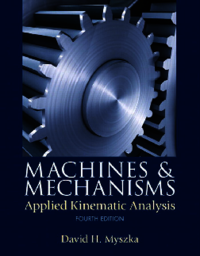
MACHINES AND MECHANISMS APPLIED KINEMATIC ANALYSIS (Fourth Edition)
53 Visitas | 82 Descargas | 2014-05-08 18:24:42 | raulito
The objective of this book is to provide the techniques necessary to study the motion of machines. A focus is placed on the application of kinematic theories to real-world machinery. It is intended to bridge the gap between a theoretical study of kinematics and the application to practical mechanisms. Students completing a course of study using this book should be able to determine the motion characteristics of a machine. The topics presented in this book are critical in machine design process as such analyses should be performed on design concepts to optimize the motion of a machine arrangement.
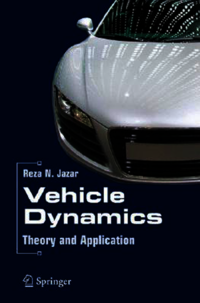
Vehicle Dynamics: Theory and Application
73 Visitas | 74 Descargas | 2014-05-08 18:32:52 | raulito
This text is for engineering students. It introduces the fundamental knowledge used in vehicle dynamics. This knowledge can be utilized to develop computer programs for analyzing the ride, handling, and optimization of road vehicles. Vehicle dynamics has been in the engineering curriculum for more than a hundred years. Books on the subject are available, but most of them are written for specialists and are not suitable for a classroom application. A new student, engineer, or researcher would not know where and how to start learning vehicle dynamics. So, there is a need for a textbook for beginners. This textbook presents the fundamentals with a perspective on future trends.
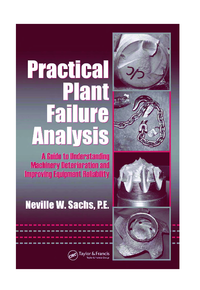
Practical Plant Failure Analysis
64 Visitas | 72 Descargas | 2014-05-08 18:38:34 | raulito
The world of failure analysis began opening up to me about 30 years ago when, as a young engineer on a plant tour, I was shown a row of six 600-hp pumps that had broken 11 pump shafts in the previous 8 or so months. The pumps were impressive, but the fact that they were repeatedly breaking 6-in.-diameter shafts was just amazing to me. After many months of charting and analyzing motor power requirements, pump flow rates, liquid temperatures, and inspecting everything else we could think of, we eventually realized that the pumps were operating far back on their curve and fatigue pulses occurred every time a vane passed the cut water. The result of this cyclical loading, combined with the shaft corrosion, was causing the failures.
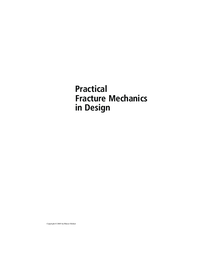
Practical Fracture Mechanics in Design, (Second Edition, Revised and Expanded)
85 Visitas | 69 Descargas | 2014-05-08 18:41:29 | raulito
This is the second edition of a book that was originally published by Alexander Blake. This edition contains revisions in each chapter, more design problems, and four additional new chapters. The underlying theme of the book “Practical Fracture Mechanics” has not been changed and the book is still intended for the design and practicing engineer. The new chapters deal with the fractographic analysis, fracture of composites, dynamic fracture, and experimental methods in fracture mechanics. Presented below is the preface from the first edition with some additions and deletions reflecting the new material included in the book.
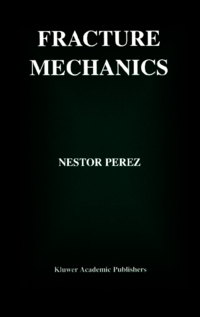
FRACTURE MECHANICS
92 Visitas | 79 Descargas | 2014-05-08 18:46:32 | raulito
This book is suitable as a textbook for a senior undergraduate and graduate textbook of a one-semester course in Mechanical, Civil, Chemical and Industrial Engineering, Materials Science as well as in Applied Physics and Applied Chemistry programs. Each chapter is self-contained and self-sufficient in descriptive details, but it keeps a smooth continuity with its preceding and following chapters. The numerical and the algebraic illustrations are just in place with the theoretical analyses and the empirical examples. Unlike many voluminous works on fracture mechanics, in this book mathematics does not overburden the physics of fracture mechanics, and thus shows a more realistic route to solve a particular problem. Hence, practicing engineers in consulting firms and design offices can use this book in a very handy and straightforward fashion. Also it is a good reference book in the personal library of many retired professionals and professors who still like to keep in touch with the reality as a hobby, pastime or pleasure.
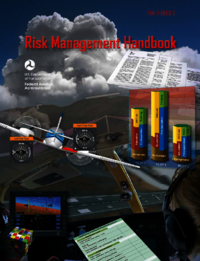
Risk Management Handbook
64 Visitas | 63 Descargas | 2014-05-29 02:49:28 | raulito
This handbook is a tool designed to help recognize and manage risk. It provides a higher level of training to the pilot in command (PIC) who wishes to aspire to a greater understanding of the aviation environment and become a better pilot. This handbook is for pilots of all aircraft from Weight-Shift Control (WSC) to a Piper Cub, a Twin Beechcraft, or a Boeing 747. A pilot’s continued interest in building skills is paramount for safe flight and can assist in rising above the challenges which face pilots of all backgrounds.
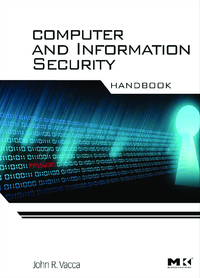
Computer and Information Security Handbook
101 Visitas | 149 Descargas | 2014-05-29 02:52:57 | raulito
The Computer and Information Security Handbook is an essential reference guide for professionals in all realms of computer security. Researchers in academia, industry, and government as well as students of security will find the Handbook helpful in expediting security research efforts. The Handbook should become a part of every corporate, government, and university library around the world.

Photovoltaic Systems Engineering, Second Edition
Engineering, Computing & Technology
58 Visitas | 74 Descargas | 2014-05-29 03:08:33 | raulito
The goal of the first edition of this textbook was to present a comprehensive engineering basis for photovoltaic (PV) system design, so the engineer would understand the what, the why and the how associated with electrical, mechanical, economic and aesthetic aspects of PV system design. The first edition was intended to educate the engineer in the design of PV systems so that when engineering judgment was needed, the engineer would be able to make intelligent decisions based upon a clear understanding of the parameters involved. This goal differentiated this textbook from the many design and installation manuals that are currently available that train the reader how to do it, but not why. Widespread acceptance of the first edition, coupled with significant growth and new ideas in the PV industry over the 3 years since its publication, along with 3 additional years of experience with PV system design and installation for the authors, has led to the publication of this second edition. This edition includes updates in all chapters, including a number of new homework problems and sections that cover contemporary system designs in significant detail. The book is heavily design-oriented, with system examples based upon presently available system components (2003). While the primary purpose of this material is for classroom use, with an emphasis on the electrical components of PV systems, we have endeavored to present the material in a manner sufficiently comprehensive that it will also serve the practicing engineer as a useful reference book.

Handbook of Photovoltaic Science and Engineering
74 Visitas | 73 Descargas | 2014-05-29 03:18:37 | raulito
You are reading a book about a technology that has changed the way we think about energy. Solar electricity, also known as photovoltaics (PV), has shown since the 1970s that the human race can get a substantial portion of its electrical power without burning fossil fuels (coal, oil or natural gas) or creating nuclear fission reactions. Photovoltaics helps us avoid most of the threats associated with our present techniques of electricity production and also has many other benefits. Photovoltaics has shown that it can generate electricity for the human race for a wide range of applications, scales, climates, and geographic locations. Photovoltaics can bring electricity to a rural homemaker who lives 100 kilometers and 100 years away from the nearest electric grid connection in her country, thus allowing her family to have clean, electric lights instead of kerosene lamps, to listen to a radio, and to run a sewing machine for additional income. Or, photovoltaics can provide electricity to remote transmitter stations in the mountains allowing better communication without building a road to deliver diesel fuel for its generator. It can help a major electric utility in Los Angeles, Tokyo, or Madrid to meet its peak load on hot summer afternoons when air conditioners are working full time. It allows homes and businesses a new level of guaranteed energy availability and security, and photovoltaics has been powering satellites orbiting the Earth or flying to Mars for over 30 years.

Compressed Air Manual
59 Visitas | 62 Descargas | 2014-05-29 03:32:40 | raulito
The Compressed Air Manual is a resource for everyone who wishes to know more about compressed air. This edition, the sixth, is in many respects extended, updated and improved compared to previous editions, of which the last was issued in 1976. Naturally a great deal has happened during these twenty or more years, nevertheless the fundamentals remain and make up the core of this Manual, which has been desired and requested by many.

Válvulas Selección, uso y mantenimiento
76 Visitas | 94 Descargas | 2014-05-29 03:38:48 | raulito
Las válvulas, incluso los dispositivos para desahogo (alivio) de presión, son una de las partes básicas en una planta en la industria de procesos químicos. En este volumen aparece una serie de consejos prácticos relacionados con las válvulas. Este libro se preparó para todos los que tienen alguna relación con las válvulas, sean diseñadores, ingenieros de proyecto, ingenieros de proceso o las personas encargadas de su mantenimiento. Con tantos estilos y opciones disponibles, ¿C ómo se puede hacer la elección atinada cuando se especifica una válvula.' ¿Cómo se determina el tamaño de las válvulas de desahogo? ¿Cuándo se debe seleccionar una válvula de accionamiento manual? Y, en tal caso , ¿de qué tipo ? Las respuestas a éstas y cientos de otras preguntas prácticas se encuentran en este libro. Se incluyen desde los aspectos básicos del funcionamiento hasta la operación y mantenimiento de las válvulas.

Practical Centrifugal Pumps
91 Visitas | 103 Descargas | 2014-05-29 03:42:43 | raulito
This books covers the essentials of pump construction, design applications, operations, maintenance and management issues and the authors have tried to provide you with the most up-to-date information and best practice in dealing with the subject. Key topics which the book homes in on are: the various types of centrifugal pumps; relevant pump terminology; pump characteristics and pump curves; pump calculations; auxiliary equipment associated with pumping circuits; operating pump systems – drafting the correct perations, controls and procedures; pump reliability definition in terms of availability, criticality and wear characteristics; pump efficiency – capital, maintenance and life cycle costs.
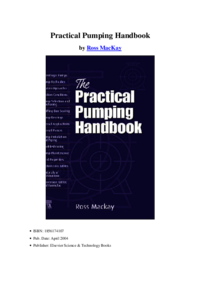
The Practical Pumping Handbook
68 Visitas | 99 Descargas | 2014-05-29 03:44:42 | raulito
A pump is an item of mechanical equipment that moves liquid from one area to another by increasing the pressure of the liquid to the amount needed to overcome the combined effects of friction, gravity and system operating pressures. In spite of the wide divergence of pump types available, over 80% of all pumps used in industry are of the single stage, end suction, centrifugal pump. The centrifugal pump moves liquid by rotating one or more impellers inside a volute casing. The liquid is introduced through the casing inlet to the eye of the impeller where it is picked up by the impeller vanes. The rotation of the impeller at high speeds creates the centrifugal force that throws the liquid along the vanes, causing it to be discharged from its outside diameter at a higher velocity. This velocity energy is converted to pressure energy by the volute casing prior to discharging the liquid to the system.
Contribuir
Usted puede contribuir con Libros UCLV, es importante para nosotros su aporte..
Contribuir